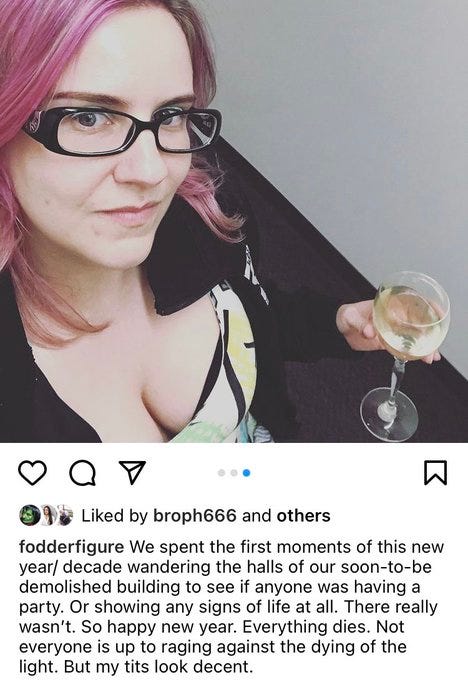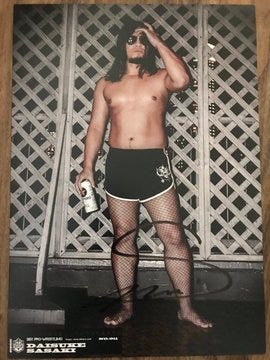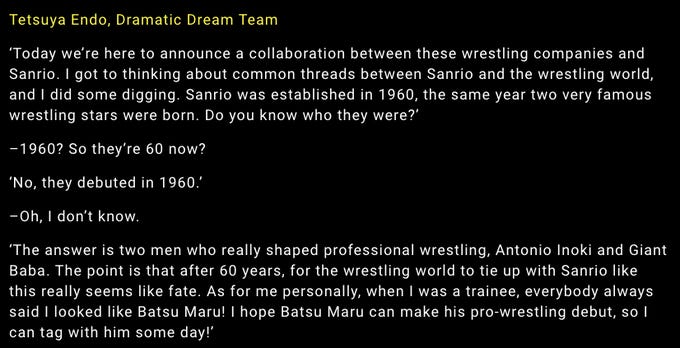So that happened.
A year ago, I was sitting in a half-packed apartment building, getting ready to vacate my home of almost eight years so that it could be, like everything in this city for which I have so much unrequited love, torn down to make way for shitty condos. Now I’m sitting in a half-unpacked apartment in a building that was recently sold, wondering how long we have before this thing is torn down, too. Which, I suppose, is an appropriate trajectory for a person trying to survive in this fucking city in this fucking year. And about as good of an outcome as it gets for anyone who’s not wealthy in Toronto. To have a home you worry about losing is an immense privilege here.
In retrospect, the Instagram post I made in the wee hours of 2020 suggests that I was at least partially prepared for this shit.
I will try to take that energy into 2021 now. I’m not sure how much longer my late bloomer tits can hold, but I’m glad they’re currently doing the best they can against time, gravity, and the despondent slouching of the person to whom they’re attached.
My Bullshit
This year marked my 20th anniversary as a professional writer, and it was the most erratic one in a notoriously erratic industry by far. I published a book, which has been my dream since Kindergarten, and my timing really couldn’t have been worse. My sincere thanks and undying gratitude to everyone who had the energy to read and support that thing in the midst of, well, you know.
I managed to publish a few stories I didn’t hate, too. Which is always a welcome respite from my usual feelings about myself and my work. I was particularly thrilled to have the opportunity to write about autism in pop culture with some nuance for this piece about Love on the Spectrum in TIME. That was a rare treat, and I’m glad I was able to make the most of it. I got to indulge both my love of creepy singing robot bears and Daisuke Sasaki having a sword and get paid for doing so! And I had an opportunity to interview Miyako Matsumoto, whom I genuinely believe is one of the sharpest and most interesting minds in any medium. (There are a few more links in this year in review thread if you’re interested.)
I also received some of the worst treatment from editors that I’ve seen in my two decades of work. One killed a story with such contempt that I seriously thought about giving up. It wasn’t the rejection. That’s part of the job. But the idea that my work was so bad that it made a professional think they had the right to treat me that way broke me. The only thing that kept me going was that I had rent to pay and sucked even more at everything else I tried.
Then I had some weird issues with killed stories that weren’t the worst, but did kick me while I was down.
But I did swear on national morning television. That was a legitimate high point.
Other People’s Bullshit
Speaking of good things I watched this year, here’s a brief celebration of the art that kept me going:
Daisuke Sasaki’s Fishnet Portraits: I have no idea what possessed the most consistently entertaining man in pro wrestling to break his fishnet stockings (for compression!) out of storage after a year and a half to pose for a series of portraits that were even more alluring than they were amusing, but I’ll always be thankful for it. “You have to write another book so that someone can profile you and do a photo shoot in your office stuffed with framed fishnet photos” is my primary source of motivation these days.
Tetsuya Endo’s KO-D Openweight Championship Reign: Endo’s my favourite, so I was going to appreciate him being on top again under any circumstances. But I really do think this current reign, which has happened under impossible circumstances, has been an understated gem. During his first run with the KO-D in 2019, I said that if you think of a wrestling championship as a thesis statement for a promotion, you’d be hard pressed to find a better and more thorough representation of what one is and can be than the DDT we’d seen via Endo. And I believe that’s been true for this one, as well. Against Masato Tanaka, he made a fine case for how well DDT can hold its own against the rest of the world. Against Yuki Ueno, he displayed what DDT can and will be in the future. Against Daisuke Sasaki, he showcased what DDT is. And established himself and his team as the emotional centre of the promotion in the process. And then went on to land DDT their first Tokyo Sports Award in ages for best technique.
He’s also proven to be an incredibly good spokesperson for DDT. I’m still charmed by his declaration that Antonio Inoki, Giant Baba, and Hello Kitty are cosmically intertwined during a press conference to promote a Sanrio/wrestling cross promotion back in the summer.
A few days ago, he declared that “it is important that we get to the top spot by letting people know about the strengths of DDT. I want DDT to become the best promotion both in Japan and in the whole world without having to lose the essence of what it truly is.” And I honestly can’t think of a better mission statement for the unique gift that is Dramatic Dream Team.
There’s something really special about Tetsuya Endo, and I look forward to even more people seeing it in 2021.
I hope we get to see more of his beetles, too.
Ted Lasso: I really needed that earnest, soft shit in my life this year. And I’m in love with Keeley. And Trent Crimm: The Independent.
The seemingly constant dumping of furniture from the building across the street: This was a thing that happened in real life and not art, but it provided great entertainment value and I watched as religiously as I watched my favourite programs, so I’m counting it. I don’t know what exactly was happening in that building over the past year, but it resulted in full apartments’ worth of surprisingly high quality mid-century modern and Miami Vice set-worthy shit being dumped on their front lawn on a near daily basis. After nearly biting on a number of pieces, including a lovely fake Eames chair, we finally went through with a proper dumpster dive and scored the loveliest end table a couple of days ago.
The Criterion Channel: When I wasn’t watching wrestling, I was watching the world’s best art films. On my phone. Usually in 30 minutes doses. Sometimes my cat tried to chew on the corner of the phone while this was happening. I realize that all of this makes me a heathen, but fuck it. At a time where everything feels out of reach, I’m glad that I found a way to make something that once meant a lot to me (i.e. watching sad and fucked up foreign films whilst being sad and fucked up) accessible to my current circumstances and executive function level. Also, being able to buy an entire year’s worth of unlimited access to so many films for the price I used to pay for one Criterion Edition DVD was a bit of a rush.
ChocoPro Wrestling: Variations of “What are art are you using for inspiration and/or coping mechanisms?” became an increasingly frequent interview question as the year wore on. Every time I was asked, I said it was Emi Sakura’s brilliant reimagining of pro wrestling for the COVID era. For sheer entertainment value, there was nothing better. It was even funnier and more heartwarming than Ted Lasso, for eff’s sake! It was also a real source of inspiration for me. I really can’t imagine where my head would be right now if I didn’t have this shining beacon of low budget magic beaming into my small space from a small space on the other side of the world multiple times a week.
I tried to write about how much ChocoPro spoke to me this past summer. After months of confusion, the story finally got killed a few weeks ago. So, in the spirit of, uh, making sandcastles out of the ashes of this fucking year (and probably next fucking year, too) I’m just going to go ahead and post the draft of that story here now.
It’s out of date and doesn’t even begin to express just how great I think ChocoPro is, but I hope it’s a start:
When I was an indie-obsessed teenager in the 1990s, chasing down every small label, press, show, screening, and zine fair I could find, I never imagined that one of the purest expressions of my philosophical and aesthetic ideals would come from a collective of people who film themselves fighting each other — and, occasionally, a basketball — in a small padded room. But that’s exactly what I’ve found in ChocoPro Wrestling, the latest brainchild from joshi legend, visionary, and AEW Superstar Emi Sakura. The no (live) audience, no paywall offshoot of the Gatoh Move promotion first seemed to appear as an on-the-fly response to the massive challenges of staging pro wrestling in a pandemic, but it has rapidly transformed into its own art form and it own business model.
Watching the members of the ChocoPro universe and their semi-frequent guests constantly innovate and adapt the way they tell stories in the physical and virtual spaces available to them and the way they hustle to support the ongoing production of their work — and then watching them discuss how and why they do all of the above— is almost as fascinating as the matches themselves. And those matches are very, very entertaining.
ChocoPro is essentially a promotion that is being envisioned and staged entirely for the internet. There has never been a single live fan in attendance at any of their shows, and there are no plans to invite any if and when it becomes possible to welcome fans back to the Ichigaya Chocolate Square where all ChocoPro and the majority of Gatoh Move events are held. But Sakura rejects the notion that she’s putting on “no audience” shows.
“There’s definitely an audience. They’re just on the other side of the camera,” she said in an interview with Yahoo News via Sports Graphic Number (translated by Johnny L.). “Other promotions may offer live broadcasts of their events, but for ChocoPro, the broadcast is the event. It’s kind of like the difference between a play and a film.”
Although it shares basic physical and virtual infrastructure as well as talent with Gatoh Move, the promotion has a vision, structure, vibe, merch line, and wrestling style all its own. ChocoPro produces a truly stunning amount of content on a daily basis, ranging from brief morning greetings, to thoughtful discussions of craft, to footage of Mei Suruga taking on life’s most important challenges, like eating a kilogram of pasta and learning how to sing FOZZY’s “Judas.” But its flagship production and raison d’être are its ChocoPro wrestling shows, which are numbered like UFC or Pride events, and broadcast live on Gatoh Move’s YouTube channel.
The tone and content of the wrestling can vary depending on the show and the ongoing angles in the Choco-verse, but the broadcasts generally follow a specific pattern: In a mix of Japanese and English, Sakura and self-proclaimed ChocoPro ace Baliyan Akki open with a general rundown of what’s going on in their world and how to sponsor them, plug their sponsors, and shout out the locations of viewers in the live group chat. Somebody sings and everyone does squats. Somewhere between one and three matches of ingenious and galaxy-brained wrestling occur featuring regulars like Sakura, Akki, Suruga, Yuna Mizumori, Mitsuru Konno, Tokiko Kirihara, and Lulu Pencil, and the occasional guest appearance by guests like Masato Tanaka, Chris Brookes and Minoru Suzuki. Then there’s some post-match discussion. Then there’s a Janken (rock, paper, scissors) tournament. The winner of said tournament gets chocolate! Finally, everyone washes their hands while singing the Gatoh Move jam “Ichiban Sukina Hito No Namae Wo Sakebou” before signing off.
(This routine has become close to my only source of stability and structure in these times.)
Like all artistic types living under capitalism, Sakura and company are trying to balance the need to eat with the drive to create. And they’re constantly figuring out how to fund both while making their work as accessible as possible to as many people as possible.
“ChocoPro is wrestling that anyone can watch, completely free of charge,” Sakura explained to Yahoo News. “If you look at it that way, it’s a lot like when you used to be able to catch wrestling on TV. I want people to take comfort in wrestling, whether they’ve got cash to spare or not. I want people to enjoy it, no matter where in the world they are. That’s what ChocoPro is all about.”
The business model that’s made wresting — or any media, really— free to audiences seems barely sustainable for large companies in traditional media now, let alone YouTube channel sports entertainment upstarts. This precariousness has only been exacerbated by COVID-19 kneecapping artists and entertainer’s ability to earn money through most of their usual means.
The ChocoPro team are as open about their challenges as they are about their aspirations and fundraising efforts that are neither pushy nor apologetic are a fixture of their shows. The pitch is essentially a gentle reminder that ChocoPro is free to watch, but not free to make. Occasionally it’s accompanied by a frank assessment of how they’re doing. Then there’s a rundown of the ways both domestic and international fans can support their work. (For the latter, that includes Patreon, PayPal, YouTube membership and Super Chat tips. In the interests of full disclosure, I am a Choco Pie on Patreon.) In addition to the satisfaction of contributing to something genuinely promising in a world where almost everything else sucks, bigger donors can also experience the joys of their names and logos becoming collateral damage in matches. The floral shop that has sponsored ChocoPro from the very beginning has even seen their arrangements frequently become foreign objects.
Of course, the most creative and admirable fundraising drives in the world would mean nothing if they weren’t supporting good content. What matters most about the ChocoPro model is that it’s facilitating some of the most creative, innovative, and exciting wrestling programming in the world today, both in terms of the matches themselves, and they way they’re presented to their audience.
The production of each episode is a DIY marvel, with the small roster for each card also taking turns filming, reffing, providing commentary and providing dashes of a capella accompaniment. They operate almost entirely out of a single room and the small alleyway on the other side of said room’s two windows.
What they do with their venue is ingenious. In addition to making the most of the mat space where the matches are, in theory, supposed to occur— and where the most serious events predominantly remain — the wrestlers have managed to incorporate almost everything that can be found within the general vicinity of Ichigaya’s walls. This including balloons, a pool float, an unhung heavy bag, random furniture, flowers, a basketball that Brookes gave Suruga on one of the first shows, the bathroom, and the windows. Both the space and the panes. The camera has been used as a taunt to great effect. The acting cameraperson has interfered to even better.
Despite the delightful and often surreal shenanigans, though, ChocoPro isn’t just a comedy promotion. When it’s playful, it’s very funny, but it’s also capable of delivering fantastic technical matches and cultivating deeply emotional ongoing stories. And no matter what tone the proceedings take, any match packed with Sakura trainees is going to have solid wrestling. While it leans toward the whimsical, it’s actually a very well-rounded product.
What the ChocoPro crew do with their virtual space might be even more impressive than what they accomplish in their physical one. From the way its stars/crew block and frame their matches to the way they’ve begun developing through all of the channels available to them — including, most memorably, a feud that escalated in the live stream chats — ChocoPro has rapidly built a style that specifically entertains and engages the audience on the other side of its camera.
In concept and in execution, ChocoPro Wrestling is a testament to what is possible when a group of talented, clever, and motivated people are given the space, (some) means, and freedom to what they do best. And the opportunity to connect with the kind like-minded folk who want to watch and support them.



